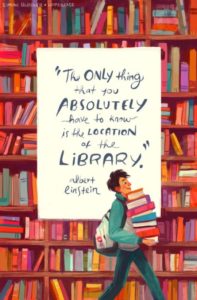Welcome back to Week 2 of “The One Thing You can do to Raise Enrollment,” a six week “how-to” series.
Did you complete your Week 1 homework assignment? If not, take a moment to search for your name on gccaz.edu, click on your employee bio page, and make a note of any information that uniquely reflects your own personal humanity.
When it comes to class enrollment, do you leave it up to chance? You have a lot to offer, and are a passionate educator. But students don’t know this about you ahead of time. What if you could influence students before you even meet them?
 Studies show that when it comes to choice, a good reputation is king. To influence a student’s choice in which class (or college) they enroll, we must increase perceived reputation. Reputation is a fragile thing, and a student’s initial experience plays a critical role in the decision-making process.
Studies show that when it comes to choice, a good reputation is king. To influence a student’s choice in which class (or college) they enroll, we must increase perceived reputation. Reputation is a fragile thing, and a student’s initial experience plays a critical role in the decision-making process.
This brings us to the old adage, “You’ll never get a second chance to make a great first impression.” A first impression is critical to reputation, and Step Two is all about taking control of the timing of that first good impression.
Timing, they say, is everything.
So, the “one thing” you can do to influence the student decision-making process, raise enrollment, and raise GCC’s reputation in an increasingly crowded marketplace is to teach others what to think about you before you even meet.
I am going to show you how to not just make a good first impression, but a viscerally good first impression, using your employee bio page. During the decision making process, students check out who is teaching a class – why? They are looking for clues for who to choose. The purpose of this blog series is for you learn how to make it easy for student to choose you, and thereby GCC. When you are done with your bio page, students who view it will “get” you. I have done random checks of comparable faculty at NAU, ASU, UofA and GCC. The sad fact is that very few instructors have posted any information on their bio page beyond name, email, and office hours.
As a result, students turn to sites such as RateMyProfessors.com to help them make a decision. The problem with these ratings sites is that other people are defining your reputation for you – and influencing reader choice. Remember, reputation is a fragile thing.
Consider the following:
“I grew up in a poor family, and I identify with the struggles some of my students have.” – Dr. Carlos Nunez
When I first read that quote, a picture of who this man is immediately formed in my mind: Genuine. Sincere. Empathetic. Successful. When I met Dr. Nunez, I quickly became aware that he was all this and more. He was courageous in and out of the classroom, and we all miss him, bless his soul.
Quotes – we love them. We share them, post them, tattoo them,  frame them and hang them on our walls. We love quotes because quotes resonate with something deep inside of us. Quotes inspire us. Quotes give us hope. Quotes make us laugh at ourselves and life. Quotes make us cry with empathy. Quotes rally us together.
frame them and hang them on our walls. We love quotes because quotes resonate with something deep inside of us. Quotes inspire us. Quotes give us hope. Quotes make us laugh at ourselves and life. Quotes make us cry with empathy. Quotes rally us together.
But the greatest power of a quote is that it connects us to each other’s humanity.
Your homework is to write a compelling introductory statement that reflects on a particular aspect of your personal journey through college. Here are a few examples to get your juices going:
- “Juggling work, family, and college was hard, but I wanted a better life.” (inspires resilience).
- “The first time I looked through a microscope I saw my future.” – (conveys vision)
- “I didn’t know what I wanted to do with my life. College helped me find my passion.” – (inspires hope)
Experiment writing statements that uniquely reflect your own personal humanity.
“It’s not up to chance, it’s up to you.” ― Rob Liano, Author and Business Speaker
Come back for Week 3, Step 3: The “One Thing” and It’s Not Bragging.











